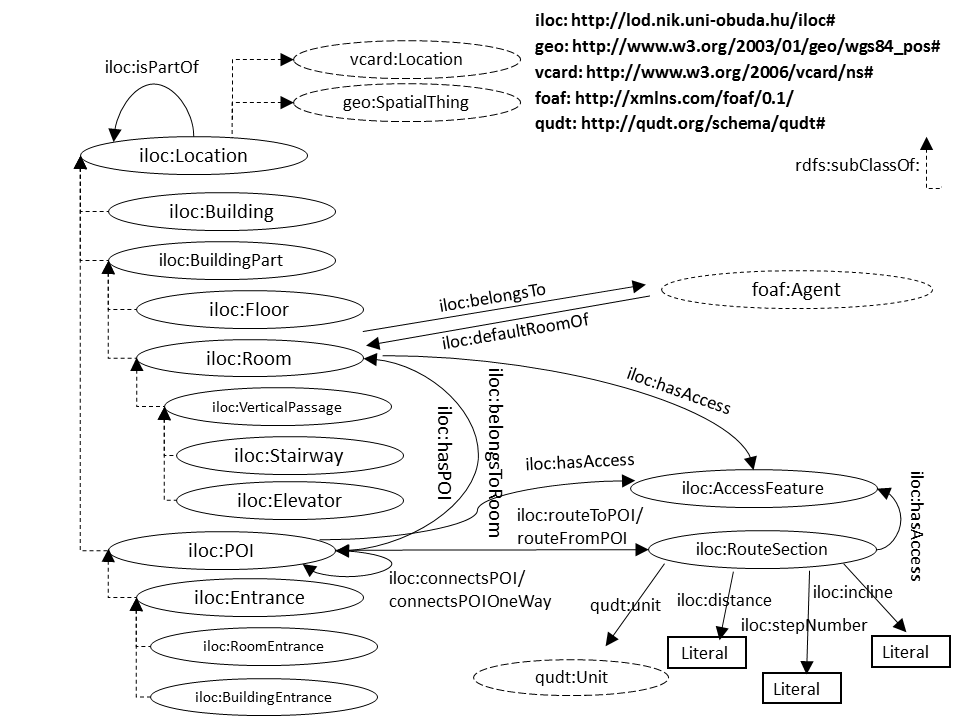iLOC – An Indoor Ontology (version 2016. 04. 09.)
Barnabas Szasz, Rita Fleiner, Andras Micsik, Gabriella Simon-Nagy
Outdoor navigation is widely supported nowadays by the means of information technology,
and the solutions usually build on coordinates provided by GPS. Inside buildings, however,
a navigation system has to cope with more complex routes and lacks the use of GPS signals.
Most of the current solutions usually require special and expensive hardware for indoor positioning.
Our aim is to present an inexpensive and simple indoor navigation method that can be adopted by
large buildings. In our work we would like to exploit the possibilities of Linked Data
and SPARQL for building flexible APIs providing location and routing information.
Many kinds of use cases can be built on this ontology, for example: supporting students at a
university in finding their next lecture; doing shopping in a mall; checking in at an airport;
finding a doctor or a specific room in a hospital.
The following is a diagram of the iLOC (version 2016. 04. 09.) classes and properties:

Download ontology in Turtle format.
1.1. Simple navigation based on the building structure
The first option is based on the structure of the building (and based on the iloc:isPartOf property) and provides simple instructions like ?Enter the main building. Go to the 3rd floor. Look for Office 307.?
The following is an example SPARQL query to select a high-level route between two rooms (even between different buildings). The query builds on the iloc:isPartOf property hierarchy and calculates an instruction in the ?helptext variable.
SELECT DISTINCT ?helptext ?sl ?fl1 ?b1 ?b2 ?fl2 ?el where {
BIND (<room1> AS ?start ).
BIND (<room2> AS ?end).
OPTIONAL {?start rdfs:label ?sl.}
OPTIONAL {?floor1 rdfs:label ?fl1.}
OPTIONAL {?floor2 rdfs:label ?fl2.}
OPTIONAL {?building1 rdfs:label ?b1.}
OPTIONAL {?building2 rdfs:label ?b2.}
OPTIONAL {?end rdfs:label ?el.}
?start iloc:isPartOf ?floor1.
?floor1 iloc:isPartOf ?building1.
?end iloc:isPartOf ?floor2.
?floor2 iloc:isPartOf ?building2.
FILTER (?building1 = ?building2 ||?floor1 = ?floor2) .
BIND (if( ?building1 = ?building2 , "same building, different floor", if( ?floor1 = ?floor2 , "same floor", "different building")) AS ?helptext) .
}
1.2. Navigation based on POI networks
The second option builds on the top of the structural description, introducing special points in the space: ?Point of Interest (POI)?. One POI instance is connected to one or multiple other POI by the iloc:connectsPOI property. The route is a chain of POIs within the POI network. As Rooms can be the target of a navigation task, it is important to relate them to the POI network. The iloc:belongsToRoom and iloc:hasPOI properties are responsible to connect the rooms to the POI network by the nearby or including POIs. The second approach is more aligned to instructions one would expect asking someone familiar with the building: ?Enter the main hall. Pass the coffee machine. Go to the elevator. Go to the 2nd floor. Pass the restrooms. Look for Room 212.? While the second approach allows more accurate navigation, there is the extra cost of modeling the POI network compared to the first approach.
The following is an example SPARQL query to select the shortest (least intermediate steps) route between two rooms in the same or different building (with maximum length of 3 steps for brevity):
SELECT ?distance ?sl ?l1 ?l2 ?l3 ?el WHERE {
BIND (<room1> AS ?start ).
BIND (<room2> AS ?end).
OPTIONAL {?start rdfs:label ?sl.}
OPTIONAL {?p1 rdfs:label ?l1.}
OPTIONAL {?p2 rdfs:label ?l2.}
OPTIONAL {?p3 rdfs:label ?l3.}
OPTIONAL {?end rdfs:label ?el.}
?p1 iloc:belongsToRoom ?start.
?p1 iloc:connectsPOI ?p2.
?p2 iloc:connectsPOI ?p3.
?plast iloc:belongsToRoom ?end.
FILTER (?p3 = ?plast || ?p2 = ?plast || ?p1 = ?plast )
BIND (if( ?p3 = ?plast , 3, if( ?p2 = ?plast , 2, if( ?p1 = ?plast , 1, -1))) AS ?distance)
} ORDER BY ?distance LIMIT 1
1.3. Advanced navigation based on POI networks
The iLOC Ontology supports more advanced navigation techniques, where the routes sections can be further described as restricted, one-way or by metrics to provide length or time duration between them. These are enabled by the RouteSection class: a RouteSection instance is associated to two POIs by the iloc:routeToPOI and iloc:routeFromPOI properties. A RouteSection might be linked to RouteConstraint instances (for example having a badge or physical ability). The QUDT ontology adds metrics to the route sections by the qudt:unit and qudt:value properties. The QUDT ontology also defines a set of units to reuse.
The following is an example SPARQL query to select the shortest route between two rooms in a building (with maximum length of three steps for brevity):
SELECT DISTINCT ?sl ?l1 ?d1 ?l2 ?d2 ?l3 ?d3 ?el (?d1+?d2+?d3 AS ?distance) WHERE {
BIND (<room1> AS ?start ).
BIND (<room2> AS ?end).
OPTIONAL {?start rdfs:label ?sl.}
OPTIONAL {?p1 rdfs:label ?l1.}
OPTIONAL {?p2 rdfs:label ?l2.}
OPTIONAL {?p3 rdfs:label ?l3.}
OPTIONAL {?p4 rdfs:label ?l4.}
OPTIONAL {?end rdfs:label ?el.}
?start iloc:hasPOI ?p1.
?r1 iloc:routeFromPOI ?p1.
?r1 iloc:routeToPOI ?p2.
?r1 qudt:value ?d1.
?r2 iloc:routeFromPOI ?p2.
?r2 iloc:routeToPOI ?p3.
?r2 qudt:value ?d2.
?r3 iloc:routeFromPOI ?p3.
?r3 iloc:routeToPOI ?p4.
?r3 qudt:value ?d3.
?p4 iloc:belongsToRoom ?end.
} ORDER BY ?distance LIMIT 1
Live SPARQL query example
